|
|
|
|
December 2021
 The first Bells of Peace ceremony at the new National World War I Memorial in Washington, DC was held on November 11, 2021. The ringing of the ship's bell 21 times was followed by the playing of Taps by three buglers in succession, echoing through the Memorial grounds. Other activities at the Memorial on Veterans Day included wreath layings by the Embassy of Serbia and the 82nd Airborne Division. The Doughboy Foundation supports the playing of Taps at 5:00 p.m. daily at the National World War I Memorial. (Photo by Bruce Guthrie)
|
|
National World War I Memorial Veterans Day Bells of Peace Ceremony to be re-broadcast on C-SPAN during December

The armistice ending World War I - and the centennial of Arlington Cemetery’s Tomb of the Unknown Soldier -- were remembered with the tolling of a U.S. Navy ship bell at the National World War I Memorial in Washington, D.C. on November 11, 2021. This is the first time that the Bells of Peace ceremony has taken place at the Memorial. C-SPAN-2 will re-broadcast the video of the ceremony on December 4, 5, 25, and 26. Click here to get more information about the dates and times of the broadcasts.
|

November 11, 2021 marked the 100-year anniversary of the first interment ceremonies at the Tomb of the Unknown Soldier. The casket holding the remains of America’s Unknown Soldier was carried back from Europe by the USS Olympia. The old ship encountered a fierce hurricane en route; as the storm battered the ship Nov. 5th and 6th, its skipper, Capt. Henry L. Wyman, feared that Olympia would sink. He knew that his courageous crew would do everything they could to keep the ship afloat, giving their lives if necessary, but the captain now believed that he needed divine intervention. He summoned for Lieutenant Edward A. Duff, a Navy chaplain who, by chance, joined the crew in Portsmouth, England to simply hitch a ride home. Click here to read what followed, and learn the rest of the story, and why the USS Olympia, still afloat in Philadelphia today, has a unique debt to the graduate of a high school there.
|
Fading ink, enduring legend:
Family’s revered diary escorted back
to World War I battlefields of France
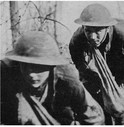
By the 1980s, World War I was fast fading from living memory. But several elderly Doughboys, then living at Phoebe Home in Allentown, PA, were still willing to share their experiences of the war that was to make the world safe for democracy, a war that would end all wars. Tragically it did neither. One among their ranks had a particularly dramatic tale to tell. He recalled crawling under the coiled rolls of barbed wire surrounding German trenches and suddenly looking up to see a small tag. As he recalled, it was stamped with the words - in English - “Barb Wire Works Allentown Pa.” As an Allentown native he recalled feeling a mixture of anger and resentment at the time, but many years later wondered at the irony of it all. Click here to read more about “the wire mill” of Allentown and how it impacted the world in and beyond World War I.
|
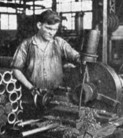
During the era of imperialism in the late 1800s and early 1900s, European powers forged military alliances among themselves, wagering that such strong alliances would discourage any attacks. However, when a conflict did erupt, it dragged the entire continent into an unexpectedly bloody and brutal war. Trench warfare and deadly new weapons created a stalemate that lasted for most of World War I. Afterward, the huge costs of war led to economic devastation for Russia and Germany, and post-war recessions occurred in the early 1920s in Britain and the United States. Click here to read more, and find how the aftereffects of WWI contributed to further disruption of the world economy.
|
Rock of the Marne:
Ulysses G. McAlexander
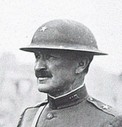
The Centenary of World War One has come and gone. A few books published, but mostly, no special remembrances occurred that garnered much attention here in the U.S. compared to Europe. Of course, the First World War affected Europe much harsher and for a much longer period than the United States. The war dragged on for a little over four long years Over There with America only involved for a little more than the last year and a half. One American who did stand out was Ulysses G. McAlexander, nicknamed “Rock of the Marne” for his leadership in one of the earliest battles American forces did fight. Click here to read more about this hero, "Oregon State’s most famous individual involved with the Great War."
|
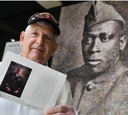
Two stern portraits of Army Sgt. Henry Johnson gaze across the east and west corridors of the National World War I Museum and Memorial in Kansas City, MO. At first, Johnson’s floor-to-ceiling portrait looks like one giant photograph. But looking closer, the faces of thousands of individuals reveal themselves from within. It’s through these photos — 3,500, to be exact — that the Museum and Memorial told not just the story of Johnson but the story of all American service members on Veterans Day. Click here to read more, and learn how the veterans' portraits were used to create the Johnson mural.
|
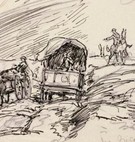
11:00 a.m., November 11th, 1918, marked the end of the Great War. But for Walt Disney, it was the beginning of chasing bright dreams which were born in the rubble of war-torn Europe. His brush with “the war to end all wars” changed his life, inspiring him to embark on a path that would lead to the creation of the world’s most beloved cartoon characters and the happiest place on earth. In 1917, America finally entered into the fray of the First World War, and patriotic Walt was ready and willing to go serve his country. His older brother, Roy, had already enlisted in the Navy, and Walt thought he “looked swell in that sailor’s uniform.” But Walt was only 16. Too young to enlist – by one year. However, surrounded by posters of Uncle Sam and rousing songs like “Over There,” Walt said desperately, “I just had to get in there.” Click here to read more, and learn how Disney concocted a foolproof plan to get Over There despite his youth: counterfeiting.
|
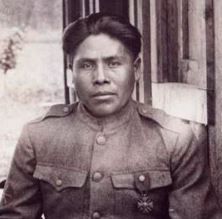
German intelligence intercepted Allied military correspondence throughout October 1918 during the Meuse-Argonne campaign. In response, the US Army enlisted the help of Choctaw Nation soldiers within the 141st, 142nd, and 143rd Infantry Regiments who were a part of the original group of “Code Talkers,” or Native American interpreters, from WWI who relayed sensitive military communications in their native languages. But Pvt. Joseph Oklahombi of the 141st Infantry Regiment went far beyond his duties as a translator when he and 23 other members of his unit participated in an attack at the Battle of Blanc Mont Ridge near Saint-Etienne-a-Arnes in France on Oct. 8, 1918. Click here to read more, and learn how Oklahombi and his force stormed the German stronghold and captured 171 prisoners.
|
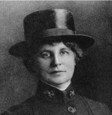
World War I was The War that Changed the World, and its impact on the United States continues to be felt a century later, as people across the nation learn more about and remember those who served in the Great War. Here's a collection of news items from the last month related to World War I and America.
|

A man is only missing if he is forgotten.
The Doughboy MIA team just returned from their first recon trip to France, where they spent a week looking into three cases of missing servicemen. The trip, named 'Recon Lashley' in honor of a generous donation made by an enthusiastic supporter of the organization, included meetings with both local and national French officials, as well as inspecting the sites where each man was last reported to be.
First was the case of Corporal Edward Malone, 307th Infantry. Killed in action on the Vesle sector in September, 1918, his body was reported buried by his sergeant and best friend, with a clear location registered. However, when Graves Registration Service (GRS) personnel went out to find him following the war, they were unable to locate him, possibly due to too much vegetative growth. DBMIA was unable to walk the actual site due to there still being crops in the field, but a full array of photos were taken for study, and locals interviewed who will be getting into the area at the earliest opportunity. A return trip to the site by the DBMIA team is being planned, possibly for the summer of 2022.
Second was the case of Sergeant John Curran, 316th Infantry. Curran was wounded, captured, died in captivity on November 7th, 1918, and was buried by the German Red Cross. His grave location was reported to the GRS by the International Red Cross Service, but GRS teams were not able to locate his grave in the temporary German cemetery where he was put, possibly due to German GRS recovery efforts of their own men. changing the lay of the land and/or eliminating the grave marker. The DBMIA team located the spot where he is thought to still be resting, photographed the area, and spoke with local French officials. While there is some more paper to dig out at the National Archives on this case, the prospects of making a second visit to the site in 2022 are very promising.
The third case - that of Corporal James Uber, 112th Infantry - has garnered a lot of attention. One of his dog tags turned up in 2018 near the spot where he was killed and brought back to the States. DBMIA got wind of the case and began an exhaustive investigation soon thereafter, While our research appears to point to Uber being recovered as an 'Unknown' - and thus interred as such at the Meuse-Argonne American Cemetery Over There - our team nevertheless contacted local French officials and arranged to investigate and photograph the site, which we did. The probability of Uber indeed being an 'Unknown' is very, very strong, but more paper at the National Archives needs to be sought out before it can be proven as such.
We appreciate all those who contributed to make Recon Lashley the success it was. Want to play a part in the next recon? Donate today! Simply visit www.ww1cc.org/mia
Can you spare just ten dollars? Give 'Ten For Them' to Doughboy MIA and help us make a full accounting of the 4,423 American service personnel still listed as missing in action from WWI. Make your tax deductible donation now, with our thanks.
A man is only missing if he is forgotten.
|
Great Christmas Gifts from the Official
Doughboy Foundation WWI Store
 Lest We Forget: The Great War World War I Prints from the Pritzker Military Museum & Library. One of the nation’s premier military history institutions pays tribute to the Americans who served and the allies they fought beside to defeat a resourceful enemy with a lavishly illustrated book. It is an official product of the United States World War One Centennial Commission and is a tribute to those who served in the Army, Navy, Marine Corps, and what would become the Air Force. It serves as a lasting reminder that our world ignores the history of World War I (and the ensuing WWII) at its peril―lest we forget.
Honoring the Doughboys: Following My Grandfather's World War I Diary is a stunning presentation of contemporary photographs taken by the author that are paired with diary entries written by his grandfather, George A. Carlson, who was a soldier in the U.S. Army during World War I. Jeff Lowdermilk followed his grandfather's path through France, Belgium, Luxembourg, and Germany and returned with these meticulously crafted photographs and his own engaging stories that bring the diary to life for contemporary readers. Lowdermilk's passion for World War I and military history began as a young boy when he listened to his grandfather tell his stories about serving as an infantryman-- a "Doughboy"--in Europe during the Great War.
Proceeds from the sale of these books will help finish the new National World War I Memorial in Washington, DC.
This and many other items are available as Official Merchandise of the Doughboy Foundation.
|
|
|
|
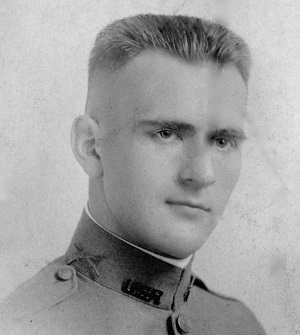
Submitted by: Michael Jon Chapman {No relation...but I have kept his story alive through my writings.}
Fred H. Becker was born around 1895. Fred Becker served in World War 1 with the United States Marine Corps. The enlistment was in 1917 and the service was completed in 1918.
Story of Service
On a warm spring day, May 14, 1921, over 5,000 people attended a funeral in Waterloo, Iowa. The mourners filled the church to the bursting point, with the overflow covering the parking lot. Later that afternoon, they packed the local cemetery as well.
They had come from all over the state to honor Fred Becker, who had given his life fighting in France during World War I. It was said to be the largest crowd ever assembled in the city nestled in the heart of the Midwest. The story behind the turnout remains one of the most inspirational in Iowa sports and military history.
Fred H. Becker was born on November 6, 1895. The Becker family lived in a modest, one-story house on the east side of the river, just two blocks from where the five Sullivan brothers – who all perished on the same ship during World War II – were raised in the 1930s.
He first gained attention in sandlot football games on dusty, makeshift fields. It was in those rough-and-tumble games that he carved out a reputation that would serve him well in the years to come. He was known all over town for his “fighting spirit”!
Becker had a highly successful high school career. Handsome and popular, he was involved in a variety of activities, ranging from football, basketball and track to several after-school clubs. He was elected vice president of the junior class, and was also a member of the German Club. Little could he have imagined that he would one day lose his life fighting against Germany, the country where his mother had been born, and where his father’s side of the family had originated.
|

|
|
|
|